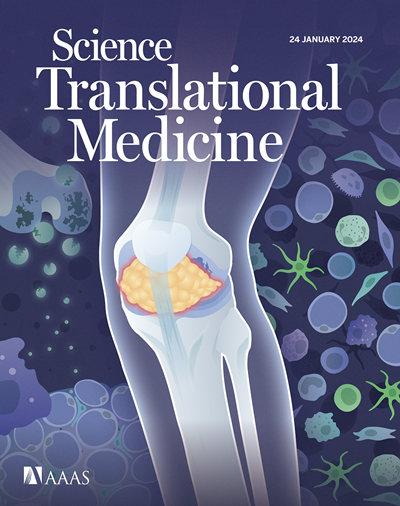小脑中zebrin-II细胞亚型的失调是多谷氨酰胺共济失调小鼠模型和患者的共同特征
IF 15.8
1区 医学
Q1 CELL BIOLOGY
引用次数: 0
摘要
脊髓小脑共济失调 7 型(SCA7)是一种由 CAG 多谷氨酰胺重复扩增引起的遗传性神经退行性疾病。浦肯野细胞(PC)是共济失调病理学的核心,但它们在小脑中的丰度较低,在测序分析中不能充分反映它们的转录组。为了解决这个问题,我们开发了一种PC富集方案,并对小鼠和SCA7患者的单个细胞核进行了测序。SCA7-266Q 小鼠的单个细胞核 RNA 测序显示,影响神经胶质细胞和多核细胞的细胞身份基因发生了失调。特别是,在有症状的 SCA7-266Q 小鼠中,标记 zebrin-II PC 亚型的基因占 DEGs 的比例最高。SCA7-266Q小鼠的这些转录组变化与免疫组化法量化的抑制性突触数量增加以及急性脑切片中PC尖峰下降有关。zebrin-II细胞亚型的失调是SCA7-266Q小鼠PC中的主要信号,与运动症状发作时小脑中zebrin-II条纹的缺失有关。此外,我们还在其他多聚谷氨酰胺共济失调小鼠模型中证实了zebrin-II条纹降解,并观察到SCA7患者小脑中zebrin-II表达减少。我们的研究结果表明,zebrin亚型调控的破坏是多谷氨酰胺共济失调症的共同病理特征。本文章由计算机程序翻译,如有差异,请以英文原文为准。
Dysregulation of zebrin-II cell subtypes in the cerebellum is a shared feature across polyglutamine ataxia mouse models and patients
Spinocerebellar ataxia type 7 (SCA7) is a genetic neurodegenerative disorder caused by a CAG-polyglutamine repeat expansion. Purkinje cells (PCs) are central to the pathology of ataxias, but their low abundance in the cerebellum underrepresents their transcriptomes in sequencing assays. To address this issue, we developed a PC enrichment protocol and sequenced individual nuclei from mice and patients with SCA7. Single-nucleus RNA sequencing in SCA7-266Q mice revealed dysregulation of cell identity genes affecting glia and PCs. Specifically, genes marking zebrin-II PC subtypes accounted for the highest proportion of DEGs in symptomatic SCA7-266Q mice. These transcriptomic changes in SCA7-266Q mice were associated with increased numbers of inhibitory synapses as quantified by immunohistochemistry and reduced spiking of PCs in acute brain slices. Dysregulation of zebrin-II cell subtypes was the predominant signal in PCs of SCA7-266Q mice and was associated with the loss of zebrin-II striping in the cerebellum at motor symptom onset. We furthermore demonstrated zebrin-II stripe degradation in additional mouse models of polyglutamine ataxia and observed decreased zebrin-II expression in the cerebella of patients with SCA7. Our results suggest that a breakdown of zebrin subtype regulation is a shared pathological feature of polyglutamine ataxias.
求助全文
通过发布文献求助,成功后即可免费获取论文全文。
去求助
来源期刊

Science Translational Medicine
CELL BIOLOGY-MEDICINE, RESEARCH & EXPERIMENTAL
CiteScore
26.70
自引率
1.20%
发文量
309
审稿时长
1.7 months
期刊介绍:
Science Translational Medicine is an online journal that focuses on publishing research at the intersection of science, engineering, and medicine. The goal of the journal is to promote human health by providing a platform for researchers from various disciplines to communicate their latest advancements in biomedical, translational, and clinical research.
The journal aims to address the slow translation of scientific knowledge into effective treatments and health measures. It publishes articles that fill the knowledge gaps between preclinical research and medical applications, with a focus on accelerating the translation of knowledge into new ways of preventing, diagnosing, and treating human diseases.
The scope of Science Translational Medicine includes various areas such as cardiovascular disease, immunology/vaccines, metabolism/diabetes/obesity, neuroscience/neurology/psychiatry, cancer, infectious diseases, policy, behavior, bioengineering, chemical genomics/drug discovery, imaging, applied physical sciences, medical nanotechnology, drug delivery, biomarkers, gene therapy/regenerative medicine, toxicology and pharmacokinetics, data mining, cell culture, animal and human studies, medical informatics, and other interdisciplinary approaches to medicine.
The target audience of the journal includes researchers and management in academia, government, and the biotechnology and pharmaceutical industries. It is also relevant to physician scientists, regulators, policy makers, investors, business developers, and funding agencies.
 求助内容:
求助内容: 应助结果提醒方式:
应助结果提醒方式:


